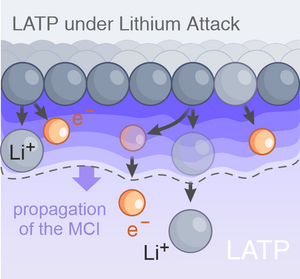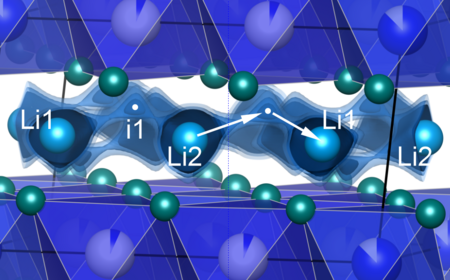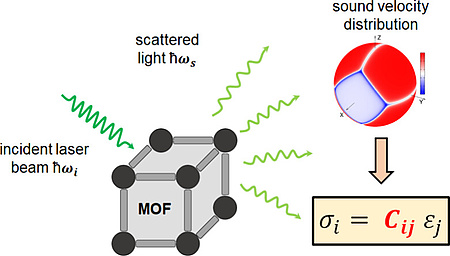
 Merry X-Mas
Merry X-Mas
As the year comes to a close, I would like to thank all members of the Institute for their dedication, professionalism, and commitment. Your scientific curiosity, teamwork, and persistence have been essential to our progress in research, teaching, and service. I am grateful for your efforts and contributions throughout the year, and I wish you all a restful holiday season, a Merry Christmas, and a healthy, successful New Year. HMRW.
 Easy access to carbenoid activity!
Easy access to carbenoid activity!
In a recent work published in Advanced Synthesis and Catalysis, researchers from the Christian Doppler Laboratory of Organocatalysis in Polymerization disclosed a modular and potentially inexpensive method of generating carbenoid reactivity in situ. Various combinations of azole compounds and oxiranes have been shown to catalyze benzoin condensation at elevated temperatures. Oxygen exclusion is unnecessary under the chosen reaction conditions.
They demonstrated the practical utility of this catalytic system by polymerizing simple, bifunctional, aldehyde/oxirane-containing monomers (e.g., the glycidylether of vanillin) using 5 mol% 1-methylimidazole in a solventless manner and without excluding air. The monomers polymerized via the formyl and oxirane groups and yielded thermoset materials with glass transition temperatures above 100 °C.
 From 1D to 3D: How NMR can resolve a sequence of Li diffusion pathways
From 1D to 3D: How NMR can resolve a sequence of Li diffusion pathways
We used 7Li spin-alignment echo and complementary NMR techniques to track Li-ion motion in Li10GeP2S12 across nearly 12 orders of magnitude in jump rates, from ultraslow local exchange at 90 K to rapid long-range diffusion near room temperature. The data reveal a clear transition from 1D/2D to 3D Li+ transport with distinct activation regimes. This provides a detailed picture of how dimensionality governs ion dynamics in one of the fastest solid electrolytes known. The JACS paper available online.
 Revealing formation reactions of lead-free BCZT piezoceramics
Revealing formation reactions of lead-free BCZT piezoceramics
Continuous effort is focused on improving lead-free piezoelectric materials, including the piezoceramic (Ba,Ca)(Zr,Ti)O3. However, unwanted secondary phases may have unpredictable influence on the performance and decrease the reproducibility. In our latest study, we used in-situ X-ray diffraction and thermal analysis to investigate the solid-state phase formation sequence of (Ba,Ca)(Zr,Ti)O3. Based on the identified formation conditions of secondary phases (see figure below), process adaptations could be applied to not only increase the phase purity, but also enhance the piezoelectric performance. Unexpectedly, we also found a new intermediate phase that could change the view on the reaction mechanism. Read more in our recent publication in the Journal of the European Ceramic Society.

 Fast Na Ion Dynamics in a Sodium Thiophosphate
Fast Na Ion Dynamics in a Sodium Thiophosphate
Fast ionic motion can drive structural change: using high-temperature Na-23 and P-31 NMR up to 650 °C, we show that Na-ion diffusion in Na4P2S6 precedes and initiates the transition to its fast-conducting rotor phase, revealing how ion dynamics can trigger phase transitions in solid electrolytes. Read the full paper in JACS.
 No more thiols needed!
No more thiols needed!
For the first time, researchers at the Technical University Vienna demonstrated that alcohols can replace thiols in formulations used in additive manufacturing. This resolves longstanding challenges associated with thiols, such as their strong odor, limited availability, and limited storage stability. The Viennese experts built on basic research conducted at the Technical University of Graz's Christian Doppler Laboratory of Organocatalysis in Polymerization, which has been pioneering the application of the so-called oxa-Michael chemistry in polymerization. Together, they developed novel photobases that promote the reaction under the desired conditions, which was key to their success. A formulation containing the aforementioned photobase, triols, and triacrylates was developed for hot lithography. This formulation can be processed via laser stereolithography and digital light processing, and it allows for the production of highly resolved 3D-printed objects. Further pushing the limits, the formulation was tested in a heated two-photon polymerization setup, demonstrating the first “hot two-photon polymerization lithography”. For more information see the article in Materials Horizons.
 Fluorination not necessary!
Fluorination not necessary!
In the Porous Materials @ Work for Sustainability project, researchers from TU Graz demonstrated that fluorinating the linkers in zirconium organic frameworks is unnecessary for improving their photostability. This is good news for the application of this material class in optical oxygen sensing and photocatalysis, as it avoids the use of potentially critical fluorinated ingredients. While seeking to improve the photostability of these materials, the researchers identified residual dimethylformamide within the porous crystals as a major source of photobleaching. Read about their research in ACS Applied Optical Materials.
 SAE NMR on diluted samples
SAE NMR on diluted samples
Solid-state diffusion is key to understanding ion dynamics in disordered materials. Using spin-alignment echo (SAE) NMR, we show how isotope dilution in glassy lithium metasilicate suppresses unwanted dipolar effects, enabling robust measurements of (ultra)slow Li ion dynamics: Advancing the Probing of Li Dynamics in NMR: Isotope Dilution Effects on Spin-Alignment Echo Generation, V. Epp, D. Wohlmuth, H. Behrens, H. M. R. Wilkening, J. Phys. Chem. 129 (2025) 129, 17334.
 2025 IEEE ISAF-ICE-ISIF-PFM conference in Graz
2025 IEEE ISAF-ICE-ISIF-PFM conference in Graz
Between July 13 and 18, we hosted over 500 leading scientists and engineers from the fields of ferroelectric, piezoelectric, and electroceramic materials, who participated at the 2025 IEEE ISAF-ICE-ISIF-PFM conference in Graz. The event was jointly organized between the Jozef Stefan Institute, Silicon Austria Labs, and TU Graz. Our Institute was responsible for local arrangements (Klaus Reichmann, Local Committee Co-Chair), technical program (Jurij Koruza, General Technical Program Co-Chair), and ICE program (Martin Wilkening, ICE Co-Chair). We thank all the supporters, volunteers, and participants for helping to make this event unforgettable!

 Zinc based coordination polymers – the GUT series
Zinc based coordination polymers – the GUT series
An interdisciplinary team of researchers supported the first author Katharina Kodolitsch as she investigated a series of of zinc(II) coordination polymers with readily accessible 3-(1H-imidazol-1-yl)propanoate ligands. The respective paper is now available at the European Journal of Inorganic Chemistry. These crystalline compounds are named as GUT (short for Graz University of Technology) and are prepared using only water as a solvent. Sodium 3-(1H-imidazol-1-yl)propanoate and sodium 3-(2-phenyl-1H-imidazol-1-yl)propanoate initially yield amorphous precipitates that convert to crystalline materials (GUT1 and GUT3) with prolonged heating. In contrast, sodium 3-(2-methyl-1H-imidazol-1-yl)propanoate immediately forms the crystalline coordination polymer GUT2. GUT2 was recently studied using Brillouin light scattering spectroscopy (see DOI: 10.1021/acs.jpclett.4c03070) and it’s thermal expansion was investigated (see DOI: 10.48550/arXiv.2504.05189). All three coordination polymers are characterized structurally by single-crystal and by powder X-ray diffraction, infrared spectroscopy supported by theoretical calculations, and thermogravimetry. Additionally, the researchers examined the compounds' solubility in water and buffer solutions. They also conducted gas sorption measurements using CO2, N2, and CH4 to study the porosity of the coordination polymers.
 Renewable epoxy thermoset
Renewable epoxy thermoset
Biobased thermosets are of significant societal interest due to their potential to address critical challenges related to sustainability, environmental impact, and resource management. However, cost, performance limitations, and feedstock concerns hamper their real-world application. Sometimes even basic knowledge is lacking. Researchers of ICTM identified a knowledge gap in the field of biobased epoxy monomers and examined the curing of epoxidized eugenol, a monomer that is only one synthetic step away from the natural product, using two industrially relevant initiators. Specifically, the Mannich base 2,4,6-tris(dimethylaminomethyl)phenol (K54) and 1-methylimidazole (1-MI) were used. They also extended their study to copolymers with the petroleum-based workhorse monomer for epoxies, bisphenol A diglycidyl ether (DGEBA) and found distinctly different curing behaviors and thermal properties depending on the initiator used, showing the potential of epoxidized eugenol as a monomer for epoxy thermoset materials. Read the details in a publication dedicated to Prof. Wolfgang Kern, who sadly passed away in 2024.
 Fast Na-Ion Dynamics in W-Na3SbS4
Fast Na-Ion Dynamics in W-Na3SbS4
Our latest study in JACS reveals that the true bulk ionic conductivity of W-doped Na3SbS4 can reach an impressive 96 mS/cm at room temperature. By using low-temperature impedance spectroscopy down to –160 °C, we isolated and quantified grain boundary effects, highlighting the path toward even faster Na⁺ transport in sulfide solid electrolytes. See Königsreiter et al. (2025) in JACS.
 Ultrafast Ion Dynamics in LTPS Probed by cryo SLR NMR wizardry
Ultrafast Ion Dynamics in LTPS Probed by cryo SLR NMR wizardry
In our latest study, we used nuclear spin relaxation techniques to investigate the unique diffusion pathways in LiTi2(PS4)3 (LTPS) down to cryogenic temperatures (10 K). Our findings reveal unprecedented details about both long-range and short-range Li⁺ dynamics, with one of the highest Li⁺ diffusion coefficients ever observed. JACS paper download: D. Tapler et int. HMR Wilkening, J. Am. Chem. Soc. (2025).
 Lithiated LATP: mixed conductors studied by NMR
Lithiated LATP: mixed conductors studied by NMR
How does lithiation affect Li transport in LATP? Using Li-7 NMR, we show that lithiation slightly enhances Li hopping rather than hindering it, shedding light on interphase dynamics in solid-state batteries. Read more in our latest study published in Comm. Chem.
 2D Ionic Conductors in Energy Science
2D Ionic Conductors in Energy Science
Ever since their discovery, low-dimensional ionic conductors have long played a crucial role as high-performance materials in electrochemical energy storage. The ternary halide Li3InCl6 serves as an archetypal material for probing 2D Li hopping between its In-rich layers, see F. Stainer, H. M. R. Wilkening, Phys. Rev. B, 109 (2024) 174304. We demonstrate 2D Li hopping using frequency-dependent spin-lock spin-lattice relaxation Li(7) NMR and shed light on the role of defects in determining local ion jumps in this layered material. Image: Analysis of the isosurface topology using softBV and the bond valence pathway finder. F. Stainer, B. Gadermaier and H. M. R. Wilkening, Chem. Mater. (2025).
 Ionic transport and diffusion in beta-alumina
Ionic transport and diffusion in beta-alumina
| A new study investigating Na ion dynamics in highly sintered Na beta-alumina using GHz conductivity spectroscopy and Na NMR, providing a comprehensive view of both short- and long-range transport. Our results reveal a conductivity of 4 mS / cm at ambient temperature, governed by an activation energy of 0.3 eV for long-range transport and 0.13 eV for short-range motions, with excellent consistency between electric relaxation and NMR data. |
The study is part of the Solid State Ionics 100 special issue initialized by Will Chueh (Stanford).
See Solid State Ionics, 2025.

 Mechanical properties of MOFs by Brillouin Scattering
Mechanical properties of MOFs by Brillouin Scattering
The mechanical properties of metal-organic frameworks (MOFs) are of high fundamental and practical relevance. A particularly intriguing technique for determining anisotropic elastic tensors is Brillouin scattering, which is used in present contribution published in the Journal of Physical Chemistry Letters. A team of researchers from 6 different institutes in Austria and the University of California studies a MOF material developed at ICTM and combines the Brillouin scattering data with simulations of elastic properties and phonon bands, which are based on machine-learning force fields and dispersion-corrected density functional theory. This provides a comprehensive understanding of the experimental signals, which can be correlated to the longitudinal and transverse sound velocities of the material. Notably, the combination of the insights from simulations and experiments allows the determination of approximate values for the components of the elastic tensor of the studied material even when dealing with comparably small single crystals, which typically limit the range of accessible experimental data.
 2D ionic transport in Li4C60
2D ionic transport in Li4C60
Lithiated Buckminster fullerene (Li₄C₆₀) has previously been identified as a fast Li⁺ ion conductor. Through our NMR analysis we characterized both long-range and localized Li⁺ dynamics. We show that long-range ion dynamics is of 2D nature and is to be characterized by an activation energy as low as 0.26 eV. Solid State Ionics, 2025.
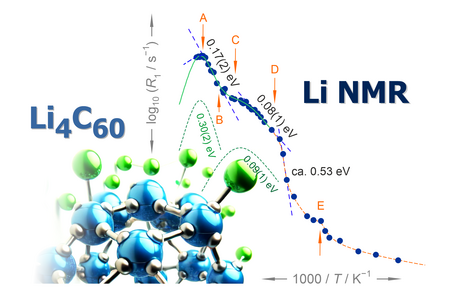
 Morphology aspects in understanding ionic conduction in thiophosphates
Morphology aspects in understanding ionic conduction in thiophosphates
Amorphous vs. crystalline: The (exact) morphology may strongly influence overall ion dynamics in many cases. For Li3PS4, if prepared via a solvent-assisted approach, the change of ionic conductivity between a fully X-ray amorphous sample and a crystalline one obtained after annealing was much less influenced by this principle. See our latest study in Dalton Trans.: Morphology-dependent Li+ ion dynamics in X-ray amorphous and crystalline Li3PS4 prepared by solvent-assisted synthesis, J. Spychala, C. Mandl, K. Hogrefe, H. M. R. Wilkening, B. Gadermaier, Dalton Trans. (2025) in press.
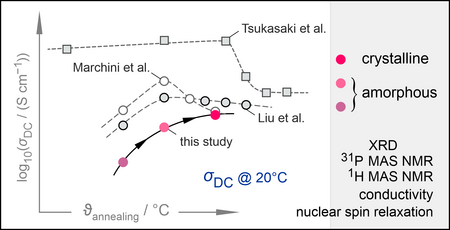
10th EuChemS Chemistry Congress
July 12-16, 2026
Antwerp, Belgium
YPRA 2026
June 29 - July 1, 2026
Leoben, Austria
12th Conference on Green Chemistry & Nanotechnologies in Polymeric Materials
June 15-17, 2026
San Sebastian, Spain
notabene: Twitter / X is still used by some of us as a news medium (for science), but we explicitly distance ourselves from the partly crude conspiracy theories and unverifiable "facts" that are often published.
You may also follow some of us on LinkedIn:













